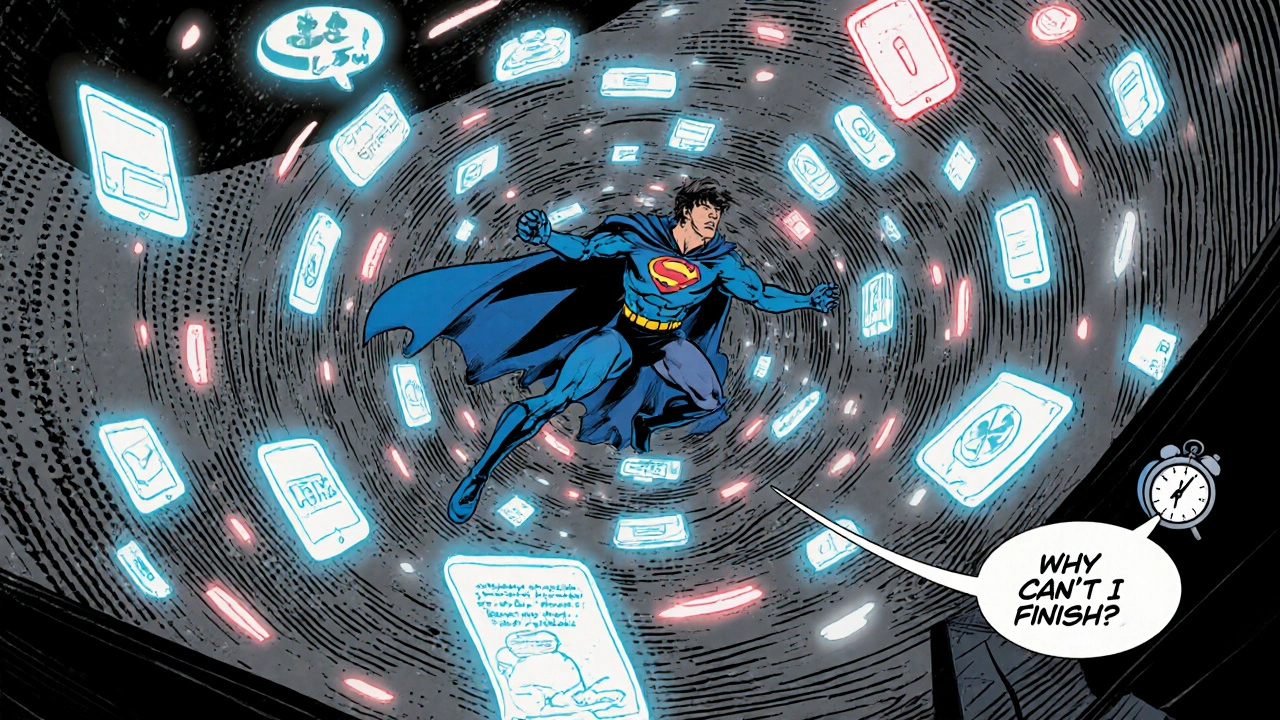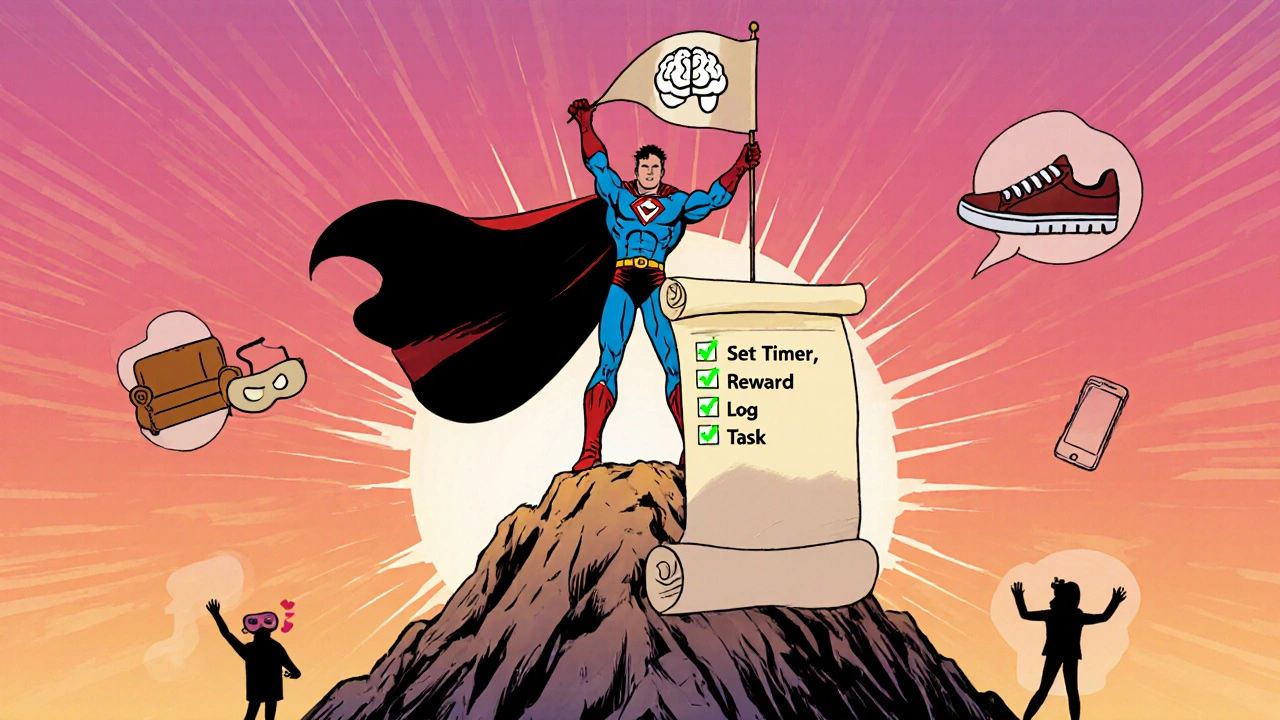
Ever feel like your brain is stuck on a loop of starting tasks, getting distracted, and never finishing? That’s a classic clash between ADHD procrastination and everyday demands. Below you’ll find practical ways to break the cycle, from quick hacks to deeper habit changes.
Key Takeaways
- Procrastination in ADHD stems from executive‑function deficits, not laziness.
- Combine external structure (timers, apps) with internal regulation (mindfulness, reward loops).
- Pick one strategy, test it for two weeks, then layer another - avoid trying to change everything at once.
- Sleep, movement, and proper medication amplify any technique you use.
- Regularly review what works; ADHD brains thrive on iteration.
Understanding ADHD and Procrastination
ADHD is a neurodevelopmental condition marked by persistent patterns of inattention, hyperactivity, and impulsivity that interfere with daily life. It affects roughly 5% of adults worldwide, according to recent epidemiological data. The brain’s prefrontal cortex, responsible for planning and impulse control, operates with lower dopamine and norepinephrine levels, making it harder to start and finish tasks.
Procrastination is the voluntary delay of an intended action despite knowing that the delay may lead to negative outcomes. While everyone procrastinates occasionally, people with ADHD experience it more intensely because the underlying executive‑function challenges amplify the pull of immediate rewards over long‑term goals.
Why Procrastination Happens: The Brain Behind the Delay
Executive function comprises working memory, cognitive flexibility, and inhibitory control. When these skills are weakened, the brain favors short‑term stimulation (checking a phone, watching a video) over the effort required to begin a demanding task. Dopamine, the neurotransmitter linked to reward, spikes when we switch to an enjoyable activity, reinforcing the habit of avoidance.
Understanding this wiring helps shift blame away from “willpower” and toward concrete, science‑backed tactics.
Core Strategies to Beat the Procrastination Loop
- External Structure: Timers, Pomodoro, and Visual Schedules
Set a timer for 10‑15 minutes and commit to working until it rings. The Pomodoro technique (25‑minute work, 5‑minute break) creates a predictable rhythm that reduces the mental load of deciding "when to start." Use a kitchen timer, phone app, or a simple watch.
- Task Chunking & Prioritization
Break projects into micro‑tasks that can be completed in under ten minutes. Label each chunk with a verb (e.g., "Draft email intro"). Prioritize using the Eisenhower matrix - urgent&important versus low‑impact - to keep focus on what truly moves the needle.
- Immediate Reward Systems
Pair each finished micro‑task with a small, enjoyable reward: a cup of tea, a 5‑minute walk, or a quick meme scroll. The brain learns that finishing work produces pleasure, gradually re‑training the dopamine pathway.
- Mindfulness & Emotional Regulation
Short breathing exercises (4‑7‑8 pattern) calm the urge to jump to a new stimulus. Apps like Insight Timer or simple grounding techniques help you notice the urge to procrastinate without acting on it.
- Cognitive‑Behavioral Therapy (CBT) & Coaching
CBT is a structured, short‑term therapy that challenges unhelpful thoughts (“I’ll never finish”) and replaces them with actionable plans. Working with an ADHD coach adds accountability and personalized workflow tweaks.
- Medication Optimization
Stimulant or non‑stimulant prescriptions improve dopamine signaling, often making the above strategies more effective. Regular reviews with a psychiatrist ensure dosage aligns with daily demands.
- Lifestyle Adjustments: Sleep, Movement, Nutrition
Aim for 7‑9 hours of consistent sleep, incorporate at least 30 minutes of aerobic activity, and maintain steady blood‑sugar levels with protein‑rich meals. These basics boost executive function and reduce the “crash” that triggers avoidance.
Toolbox: Apps and Physical Aids That Fit ADHD Brains
- Todoist or TickTick - supports tags, priority flags, and recurring reminders.
- Forest - a visual Pomodoro app that grows a tree when you stay focused.
- Sticky notes or whiteboards placed at eye level - external cues that keep tasks visible.
- Noise‑cancelling headphones with binaural beats - reduces auditory distractions.
- Wearable timers (e.g., TimeFlip) - a tactile way to switch between work and break modes without opening an app.
Comparison of Core Strategies
| Strategy | Primary Benefit | Implementation Effort | Best For |
|---|---|---|---|
| External Timers (Pomodoro) | Creates clear start/stop cues | Low - just set a timer | People who get stuck deciding "when" |
| Task Chunking | Reduces perceived effort | Medium - needs task breakdown | Complex projects or long‑term goals |
| Reward Loops | Re‑trains dopamine to link work with pleasure | Medium - set up small incentives | Those who chase instant gratification |
| CBT / Coaching | Changes underlying thought patterns | High - weekly sessions | Chronic procrastinators with negative self‑talk |
| Medication | Boosts neurochemical capacity for focus | High - medical evaluation required | Anyone whose symptoms greatly impair daily life |
| Lifestyle (Sleep/Exercise) | Improves overall executive function | Variable - habit formation needed | Everyone - foundational support |
Quick Implementation Checklist
- Choose one micro‑task for today and set a 10‑minute timer.
- Write a tiny reward you’ll enjoy right after the timer ends.
- Log the completed task in a digital or paper tracker.
- Reflect in a journal: what distracted you? How did the reward feel?
- Repeat the cycle three times, then add a second micro‑task.

Common Pitfalls & How to Dodge Them
- All‑or‑nothing mindset: If you miss a timer, don’t quit. Reset and try again.
- Too‑big rewards: Oversized treats can become the new procrastination trigger.
- Relying solely on willpower: Pair mental effort with external cues - alarms, visual boards, or a buddy.
- Neglecting health basics: Skipping sleep or meals erodes executive function faster than any tool.
Frequently Asked Questions
Can I overcome procrastination without medication?
Yes. Behavioral techniques like Pomodoro, task chunking, and reward systems can produce noticeable improvements, especially when combined with good sleep, regular exercise, and possibly CBT. Medication, however, can accelerate progress for many adults by balancing dopamine levels.
How long does it take to see results from CBT for ADHD procrastination?
Most people notice a shift after 6‑8 weekly sessions, though ingrained habits may take 3‑4 months of consistent practice to fully reshape.
Is the Pomodoro method suitable for creative work?
Absolutely. Short, focused bursts help maintain flow while the brief breaks prevent mental fatigue. Adjust the interval (e.g., 45‑minute work, 10‑minute break) to match your creative rhythm.
What type of exercise works best for ADHD focus?
Aerobic activities like running, cycling, or brisk walking boost dopamine and norepinephrine. Aim for at least three 30‑minute sessions weekly, and notice how your ability to start tasks improves afterward.
How can I prevent distractions from my phone?
Turn on "Do Not Disturb" during timed work blocks, use app blockers like Freedom, and place the phone in another room or a designated “off‑site” spot. The less visual access, the easier it is to stay on task.
Next Steps & Troubleshooting
If the 10‑minute timer feels too short, extend to 20 minutes; if it feels too long, split into two 15‑minute segments. Track your energy levels: if you notice a slump after lunch, schedule a brief walk before the next work block. When a strategy stalls, switch to a complementary one rather than abandoning the process entirely.
Remember, beating procrastination with ADHD isn’t a one‑time fix. It’s a series of experiments, tweaks, and self‑compassion. Keep a simple log of what you tried, what clicked, and what didn’t - that log becomes your personal playbook for future projects.
David Stephen
September 20, 2025 AT 01:03Starting with a single 10‑minute block can feel like a tiny victory, and that feeling feeds the brain’s reward system. Keep a simple log of those wins and you’ll notice momentum building over days. It’s not about overhauling your whole routine overnight, just about consistent micro‑steps.
John Blas
September 20, 2025 AT 01:11Another fluff post promising miracles while ignoring the real struggle!
Darin Borisov
September 20, 2025 AT 01:20The phenomenology of executive dysfunction in ADHD is often obfuscated by reductive layman narratives that equate procrastination with mere laziness, a conflation that perpetuates stigma and hampers therapeutic progress. Contemporary neurocognitive models posit that dysregulated dopaminergic signaling within the prefrontal circuitry engenders a predilection for immediate reinforcement, thereby biasing attentional resources toward salient but peripheral stimuli. This neurobiological premise undergirds the rationale for employing time‑boxing interventions, yet one must calibrate such tools to the individual’s chronobiological profile. Moreover, the hierarchical stratification of tasks, when superimposed upon a fragmented working memory substrate, can exacerbate cognitive overload, precipitating task‑aversion cycles. It is imperative, therefore, to adopt a modular decomposition paradigm that delineates actionable units no larger than the span of a single attentional bout. Concurrently, the integration of multimodal sensory cues-auditory beeps, tactile timers, or visual timers-can scaffold the initiation threshold by externalizing the executive cue. From a psychophysiological perspective, aerobic exercise augments cerebral blood flow and upregulates neurotrophic factors, furnishing a neurochemical milieu conducive to sustained focus. Nutritional considerations, particularly the modulation of glycemic index, mitigate oscillatory energy valleys that often masquerade as motivational deficits. The synergistic convergence of pharmacological titration, behavioral structuring, and lifestyle optimization constitutes a tripartite framework that aligns with evidence‑based practice. Furthermore, the dialectic between intrinsic motivation and extrinsic reinforcement must be negotiated carefully to avoid dependency on token rewards. In clinical settings, structured CBT protocols targeting maladaptive meta‑cognitions have demonstrated efficacy in reconfiguring the appraisal of task difficulty. Peer‑supported accountability mechanisms also furnish a sociocultural buffer against isolation, which is a known precipitant of disengagement. Ultimately, the construct of “willpower” should be reframed as a finite executive resource, amenable to replenishment through strategic rest cycles. By operationalizing these principles within a personalized implementation matrix, individuals with ADHD can transcend the inertia that characterizes procrastinatory loops. The longitudinal assessment of such interventions, via iterative self‑report and objective performance metrics, is essential for adaptive refinement. In sum, a nuanced, multimodal approach anchored in neurobiological insight offers the most robust pathway to ameliorating procrastination in ADHD populations.
Sean Kemmis
September 20, 2025 AT 01:30The strategies listed lack solid empirical grounding. People need practical accountability, not just trendy apps. Easy fixes rarely address the core neurochemical deficit. Without medical oversight, many methods remain superficial.
Nathan Squire
September 20, 2025 AT 01:40Sure, you can “just set a timer” and magically become a productivity wizard, but only if you also remember to take your medication and not binge‑watch Netflix during the break. In reality, the timer is a cue, not a cure, and the real work lies in calibrating your environment so the cue actually triggers focus. Think of it as a low‑budget therapist that nudges you, not a substitute for structured treatment.
Matthew Marshall
September 20, 2025 AT 01:50If you think timers solve everything, you’re living in a fantasy. Real progress demands deeper habit restructuring.
Lexi Benson
September 20, 2025 AT 01:56While the enthusiasm for every new app is admirable, constantly switching tools can be counterproductive; stick with one system long enough to see if it truly works.
Vera REA
September 20, 2025 AT 02:06Interesting how different cultures approach time management-some prioritize rigid schedules, while others embrace a more fluid rhythm. It’s worth noting that the “one‑size‑fits‑all” mindset often ignores these cultural nuances, which can actually enhance personal productivity when respected.
John Moore
September 20, 2025 AT 02:13Great points all around; the key is to experiment responsibly, combine the evidence‑based methods, and stay supportive of each other’s journeys. Sharing successes and setbacks openly can turn individual trials into a community of collective growth.